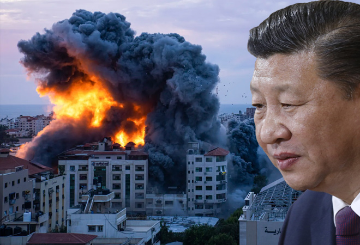
Earlier this month, the US State Department released its Country Reports on Terrorism 2018 – an annual report submitted to the US Congress on international counterterrorism efforts. On India, the report deemed “continued weaknesses in intelligence and information sharing” to have “negatively impacted state and central law enforcement agencies”.
Last year, US-India cooperation on homeland security reportedly hit a roadblock, when an “ambitious plan for exchange of information on terrorists on a real time basis between India and the US” was “dropped”. At the subsequent India-US Counterterrorism Joint Working Group and Designations Dialogue held in March 2019, that report stood validated. Absent of any announcement, the joint statement only outlined the parties to have held a “discussion of strengthening cooperation on information sharing and other steps to disrupt the ability of terrorists to travel”.
According to a senior officer, implementation of the Homeland Security Presidential Directive (HSPD-6) – an agreement on exchange of terrorist screening information between the US’ Terrorist Screening Centre (TSC) and India’s Intelligence Bureau (IB) – was “taken off from the agenda”. Discussions on the agreement failed to materialise as Indian agencies reportedly suggested that, “in return of signing of the agreement, India must secure from the US side progress to the internet related data held by US-based services.”
The “Sovereignty Hawk” – Linking HSPD-6 to divergence on data localisation
Over the past year, India and the US have increasingly found themselves at odds over trade. Under the Trump administration’s impetus on seeking “fair and reciprocal” trade deals with partner nations, India’s trade surplus with the US has come into question. Although there has been a recent decline in the deficit owing to increased Indian import of US energy supplies and defence platforms, long-standing market-access issues over American pharmaceutical imports and dairy products continue to hinder prospects of a trade deal.
In the past, continued wrangling on such market-access issues led to the US deeming India as a “sovereignty hawk”. In further compounding those long-standing issues, new bones of contention have also emerged. As a result, American characterisation of India being a forceful vanguard of her sovereign interests stands accentuated.
One new contention is over the storage of data collected by American e-commerce giants in India. New Delhi’s thinking on the same is that data “generated by Indians should be viewed as a natural resource that must be protected by the state through localisation.” Whereas, in guarding the interests of American companies, the Trump administration has characterised this divergence within the broader context of US-India trade tensions. For instance, the 2019 National Trade Estimate by the US Trade Representative addressed the US’ intent to oversee reduction in “barriers to digital trade”. Specifically, it even slammed India for its “onerous data localization requirements.”
Moreover, earlier this year, the Trump administration reportedly even mulled capping the issuance of H1B visas to 15 percent for any country that “does data localisation”. This linkage of American stance on digital trade to US immigration policy, spread jitters across India’s USD 150 billion IT sector which rakes-in about 70 percent of the 85,000 H1B visas issued every year.
Similarly, one may argue, India linking its interests on data localisation to its will on HSPD-6, signifies the realpolitik employment of leverage between bargaining parties. However, cooperation on homeland security must be prioritised given the potentialities of the HSPD-6.
Implement HSPD-6 – Upgrading US-India counterterrorism operations
On the international stage, India is a prominent voice on counterterrorism efforts. For over two decades, India has led the charge at the United Nations on the Comprehensive Convention on International Terrorism – which seeks a comprehensive definition of terrorism accepted by the General Assembly. India is also a member of the Financial Action Task Force (FATF), the Eurasian Group on Combatting Money Laundering and Financing of Terrorism, and the Asia-Pacific Group on Money Laundering. Here, India’s cooperation with the United States is also apparent. For instance, last year, there was little daylight between India and the US on the FATF grey-listing Pakistan for “outstanding counterterrorism deficiencies”.
On the domestic front however, that promising cooperation stands hindered by the holdout on HSPD-6.
In 2016, India and the US signed an agreement to “exchange terrorism screening information”. As agreed, India’s Multi-Agency Centre (MAC) established under its Intelligence Bureau disseminates the acquired intelligence to relevant central and state security agencies. With MAC as the sole entity, however, to coordinate with over two dozen representatives from over a dozen Indian intelligence agencies, the IB’s direct institutional connect with the American TSC remained weak.
With HSPD-6, India would also be part of a network of over three dozen partner nations – with which the US has already put into force that agreement.
With the speed and veracity that threats – from lone wolf attacks to full blown state-sponsored terrorist actions – come into the purview of law enforcement and intelligence agencies, it is critical for information to be shared in real time. More so, the same must be done in a secure manner in order to protect the general public. The key advantage the Indian and American governments will have over those wishing to do ill to their citizens, is the ability to share threat assessments – from particular individuals, before an untoward incident occurs. Thus, stalling on HSPD-6 renders both nations’ citizens to stand at greater risk.
Moreover, today, the sheer volume of electronic data that is collected, as compared to almost 20 years ago, necessitates such a partnership over real-time information sharing. Sixteen years since it was first issued, it is helpful to remember exactly what was encompassed in the original HSPD-6 draft, and just how relevant it still is. The ‘Directive on Integration and Use of Screening Information To Protect Against Terrorism’ sought to preemptively “develop, integrate, and maintain thorough, accurate, and current information about individuals known or appropriately suspected to be or have been engaged in conduct constituting, in preparation for, in aid of, or related to terrorism (Terrorist Information)”.
Thus, to not fully implement HSPD-6, as it was first issued by President Bush in 2003, is to dramatically weaken the ability of both countries to mutually “protect against terrorism”.
Security First – Compartmentalising US-India homeland security cooperation
Institutionalised cooperation on homeland security is a fairly recent avenue in the US-India partnership timeline. Back in November 2010, President Barack Obama and Prime Minister Manmohan Singh announced the initiation of the Homeland Security Dialogue between the Ministry of Home Affairs and the Department of Homeland Security to “further deepen operational cooperation, counter-terrorism technology transfers and capacity building.”
The same was instrumental in collating efforts of supplementary mechanisms like the Joint Working Group on Counter-terrorism – which was established way back in 2000; the Defense Policy Group; the Joint Working Group on Information and Communications Technology and the Aviation Security Working Group; and the Counter-terrorism Cooperation Initiative.
However, as evidenced by the HSPD-6 instance, cooperation on this front has been susceptible to hiccups on other avenues of US-India bilateral ties. Here’s where the US and India must take a page from their defense ties.
As discussed, under Trump, trade tensions with India have come to the fore. US-India defense ties, however, are progressing unhindered. Beyond the continued centrality of India in the American security calculus in the Indo-Pacific region, this compartmentalisation has been possible due to either nation’s efforts at institutionalising defense ties. Notably, the Modi dispensation, in its relations with the Obama and Trump administrations put heavy emphasis on force interoperability agreements and defense trade.
For the institutionalisation of homeland security cooperation, here are some recommendations:
- Institute dialogue between India’s Home Ministry and the US Department of Homeland Security (DHS) also as an integrated joint-dialogue with the US State Department and India’s Ministry of External Affairs. Along the lines of US-India 2+2 Ministerial Dialogue with foreign and defence cabinet heads, this will elevate homeland security cooperation as a priority avenue under the broader ambit of US-India bilateral relations.
- Institute department-level confidence building measures like case-by-case review of new profiles that hold Indian citizenship.
- Establish a hotline between commensurate ranks of IB and TSC to reduce turn-around time on the case-by-case reviews.
- On ensuring that privacy concerns do not hamper security cooperation, the US and India should put in place advisory boards that would “convene leading tech companies – both foreign and domestic – as well as national security and law enforcement officials”.
- Finally, for the long-term, on seamless data-sharing, India and the US should contemplate an agreement “potentially modeled on the Clarifying Lawful Overseas Use of Data (CLOUD) Act.” This would help in exploring safe channels for either countries’ law enforcement agencies to obtain evidence stored in India and the US.
In summation, as the upgrade of counterterrorism cooperation between India and the US stands hinged on inking the HSPD-6, New Delhi and Washington must seek its compartmentalisation – much like their bilateral defence ties. Moreover, the American linking of data localisation to H1B visas is off the table, as Secretary of State Mike Pompeo assured India earlier this year. That is all the more reason for India to build a precedent of delinking promising developments from divergences on other avenues.
Douglas Smith is former Assistant Secretary for the Private Sector at the US Department of Homeland Security (DHS), and currently Managing Director at Kent Strategies.
The views expressed above belong to the author(s). ORF research and analyses now available on Telegram! Click here to access our curated content — blogs, longforms and interviews.




 PREV
PREV


